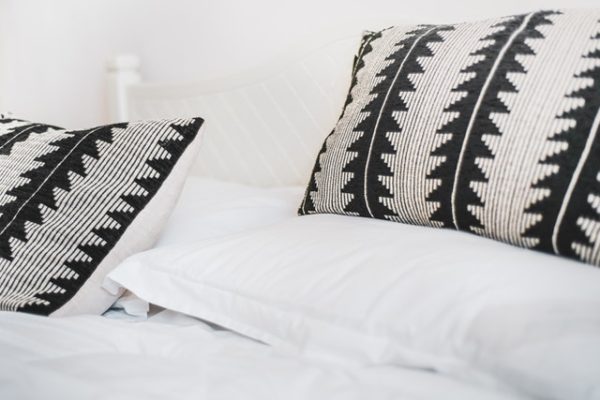You spend a third of your life in bed, so it’s important to make sure you’re sleeping on the right mattress and using the right pillow for your comfort.
But if you’re like most people, you don’t change your pillowcase every day. There’s a big chance your pillows may be holding onto a lot more than just sweat and oil.
Bacteria, yeast, mold spores, dust mites, and pet dander can all be living on your pillows – and they produce an unpleasant smell that can negatively affect how well you sleep, not to mention trigger allergies.
But you don’t have to worry. A little baking soda is all you need. Deodorize and clean your pillows the natural way!
In this article, I’ll show you how to clean and deodorize your pillows with baking soda.
Let’s begin.
Deodorizing Pillows Without Washing
What You’ll Need:
Baking soda
Pillowcase or pillow protector
Stinky pillow
Steps:
- Put the pillowcase on the pillow.
- Sprinkle a liberal amount of baking soda inside the pillowcase.
- Zip it up and shake to spread the baking soda. Leave it overnight.
- Remove the pillowcase and shake off the baking soda.
Spot Cleaning Stains On Pillows
What You’ll Need:
Baking soda
Water
Clean brush
Bowl
Tablespoon
Steps:
- Make a paste by mixing 1 tablespoon of baking soda with 1 tablespoon of water in a bowl.
- Apply the paste to the stain. Let it sit for 30 minutes.
- Use a brush to scrub off the paste. Make sure you remove all the baking soda.
Washing Your Pillow with Baking Soda
You can also use baking soda for washing your pillows. Just use a cup of baking soda on the first wash cycle instead of soap. Then use laundry soap on the next cycle like usual.
Always wash your pillows with cold water on a gentle cycle.
What makes your pillow stink?
Sweat, oils, saliva, hair, and pet dander all leave odor-causing bacteria on your pillows. The odor-causing bacteria are then allowed to breed and thrive in the warm, moist environment that has been created underneath your pillow.
How to prevent stinking up your pillows
- Change the pillowcase with fresh ones every week.
- Use pillow protectors. Pillow protectors add an extra layer of protection.
- Check the pillows’ expiration date. They should be replaced every 2 years. Some hotels even write the expiration date on their pillows to remind them when it’s time for new ones.
- Give your pillows some sunshine. The UV rays from the sun can kill odor-causing bacteria. Just make sure it’s not direct sunlight. Too much heat can deform or damage your pillows.
How to Properly Dry Pillows
Wet pillows can develop mildew and mold, so it’s important to dry them thoroughly after washing. To dry pillows, use low heat and fluff them every 15 minutes until they’re completely dry.
Alternatively, you can air-dry pillows outdoors on a sunny day, but avoid direct sunlight, which can damage or deform your pillows.
How Often to Clean Pillows
While it’s recommended to change pillowcases every week, how often should the pillows themselves be cleaned? A general guideline is to wash or deodorize your pillows every 6 months, or more frequently if you have allergies or asthma.
However, pillows that are heavily soiled or have a strong odor may require more frequent cleaning.
Using a Vacuum Cleaner on Pillows
Vacuuming pillows can help remove dust mites and other allergens that can cause unpleasant odors. Use a handheld vacuum or the upholstery attachment on your regular vacuum and run it over both sides of the pillow.
Pay special attention to the seams and edges, where dust and debris tend to accumulate.
Choosing the Right Pillow
The type of pillow you use can affect its odor and how often it needs to be cleaned. Down pillows, for example, are known to trap more moisture and require more frequent cleaning than synthetic pillows.
Consider using hypoallergenic pillows if you have allergies or asthma, and replace your pillows every 2 years to maintain their freshness and support.
Other Natural Deodorizers
Besides baking soda and essential oils, there are other natural ingredients that can be used to deodorize pillows. For example, white vinegar has antibacterial properties and can help remove odors. To use vinegar, mix equal parts of water and vinegar in a spray bottle and mist your pillow. Let it air dry before using.
Another option is activated charcoal, which can absorb odors and moisture. Simply place a small bag of activated charcoal inside your pillowcase and leave it there for a few hours or overnight.
Conclusion:
That’s how I combat foul pillow odors with baking soda.
Give these methods a try the next time you have to de-stink a pillow.
I hope that you found this article helpful.
Thank you for reading my blog!
-Baking Soda Guy
FAQs:
Q: How often should I change my pillowcase to avoid odors?
A: It is recommended to change your pillowcase every week to prevent odors and maintain freshness.
Q: Can I use baking soda on any type of pillow?
A: Baking soda is generally safe for most types of pillows, but it’s a good idea to spot-test a small area before applying it extensively.
Q: How frequently should I clean or deodorize my pillows?
A: A general guideline is to clean or deodorize your pillows every 6 months, but heavily soiled or smelly pillows may require more frequent attention. Individuals with allergies or asthma may need more frequent cleaning.
Q: Can I use a vacuum cleaner to remove allergens from my pillows?
A: Yes, vacuuming pillows can help remove dust mites and allergens. Use a handheld vacuum or the upholstery attachment on your regular vacuum for this purpose.
Q: What is the proper way to dry pillows after washing them?
A: To avoid mildew and mold, it’s essential to dry pillows thoroughly after washing. Use low heat and fluff them every 15 minutes until completely dry. Alternatively, air-dry pillows outdoors on a sunny day, but avoid direct sunlight to prevent damage or deformation.
Q: Are there other natural deodorizers I can use for my pillows?
A: Yes, besides baking soda and essential oils, you can use white vinegar, which has antibacterial properties, or activated charcoal, which absorbs odors and moisture, as natural deodorizers.
Q: How can I prevent my pillows from smelling bad in the first place?
A: Regularly changing pillowcases, using pillow protectors, and exposing pillows to sunlight can help prevent foul odors. Additionally, consider choosing hypoallergenic pillows if you have allergies or asthma and replace pillows every 2 years.
Q: Can I wash my pillows in a washing machine?
A: Some pillows are machine washable; however, always check the manufacturer’s instructions before washing them. It’s essential to use a gentle cycle with cold water and low heat when drying.
Q: Can baking soda help with allergens on pillows?
A: Baking soda can help neutralize odors, but it may not effectively remove all allergens. Vacuuming and using other natural deodorizers can be beneficial for allergen removal.
Q: Can I use baking soda on memory foam pillows?
A: Baking soda can be used on memory foam pillows, but it’s best to spot-test first and avoid excessive moisture, as memory foam can retain water.
Top Photo by laura adai from Pexels

